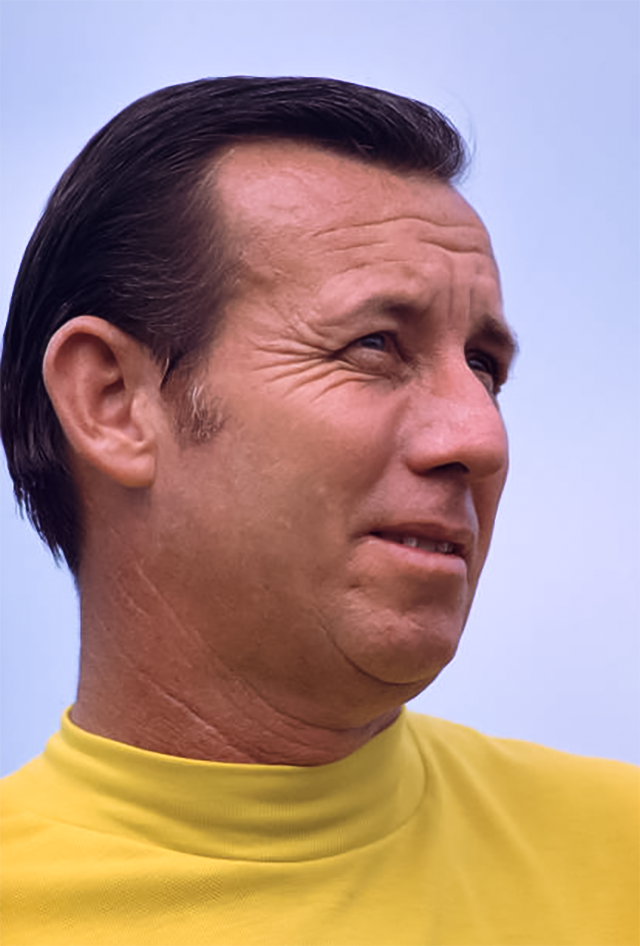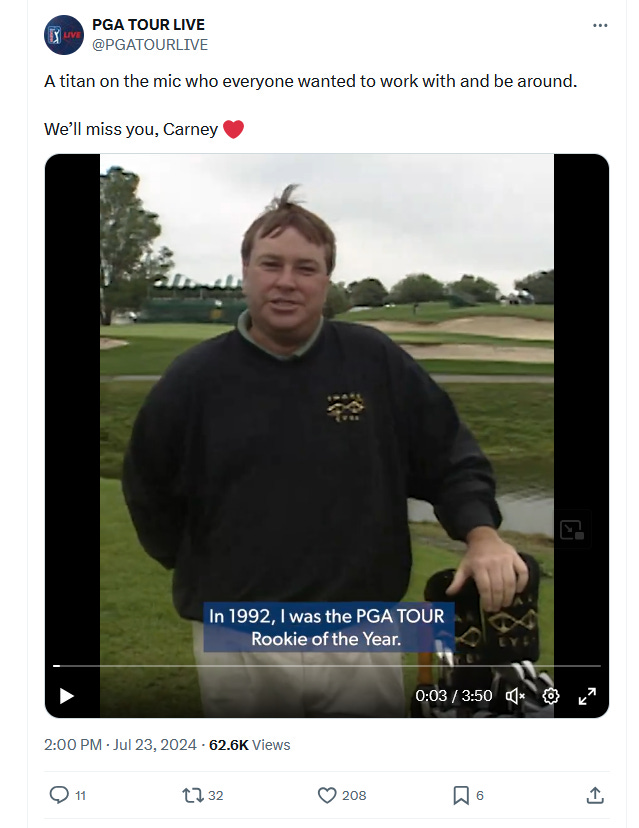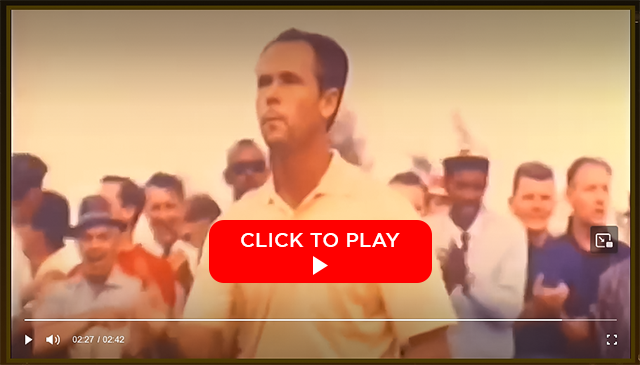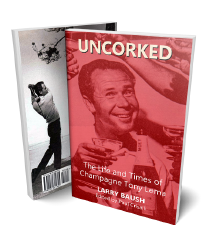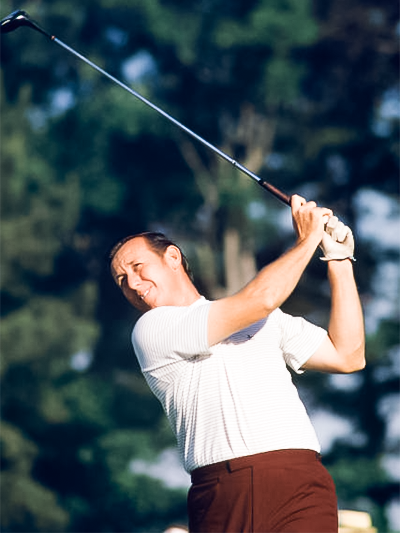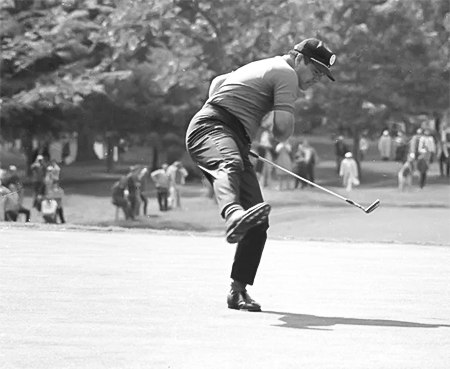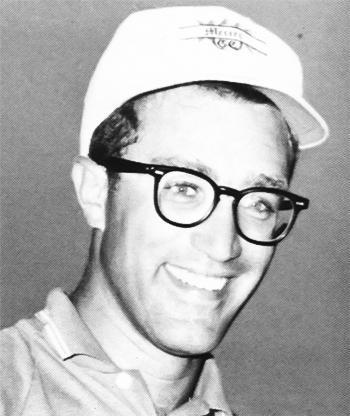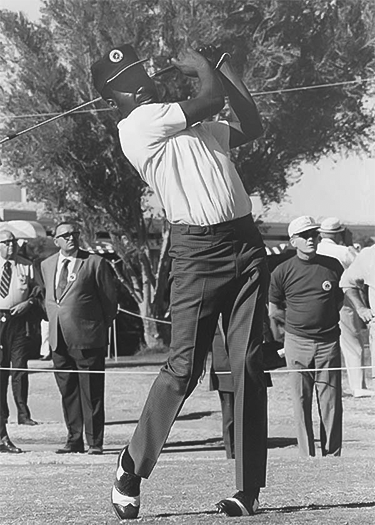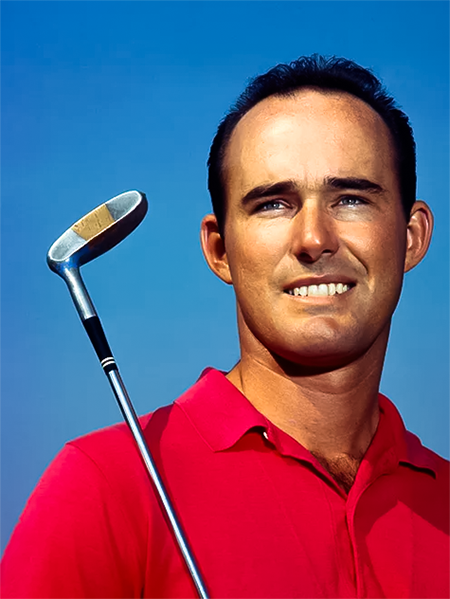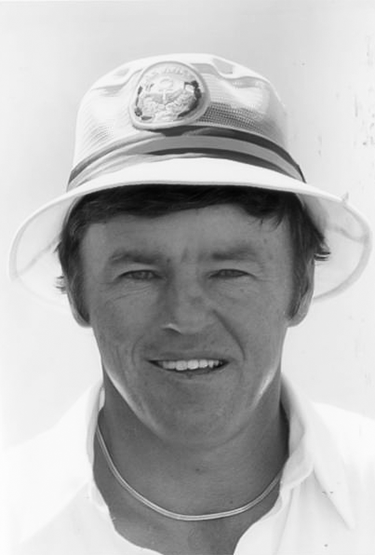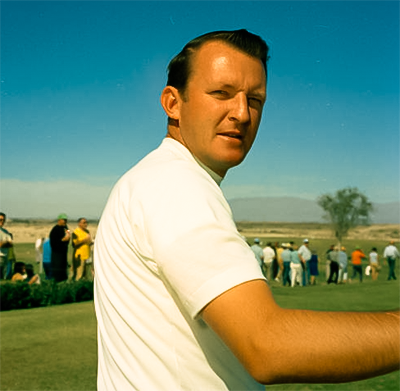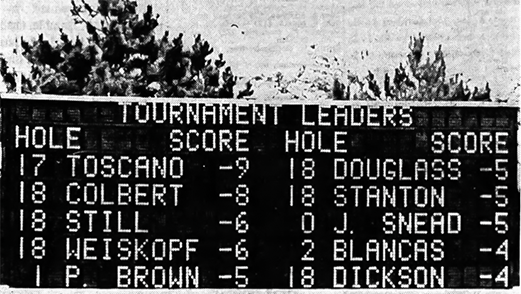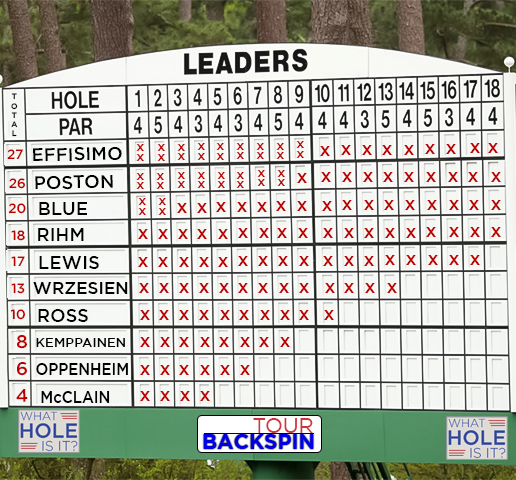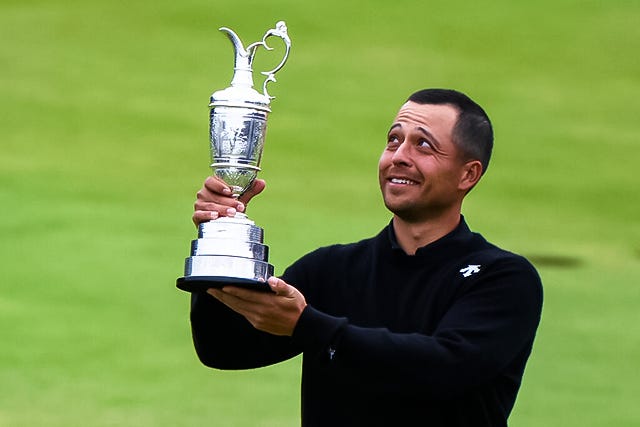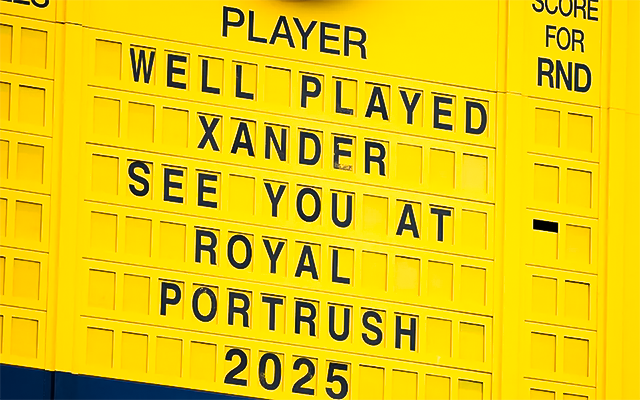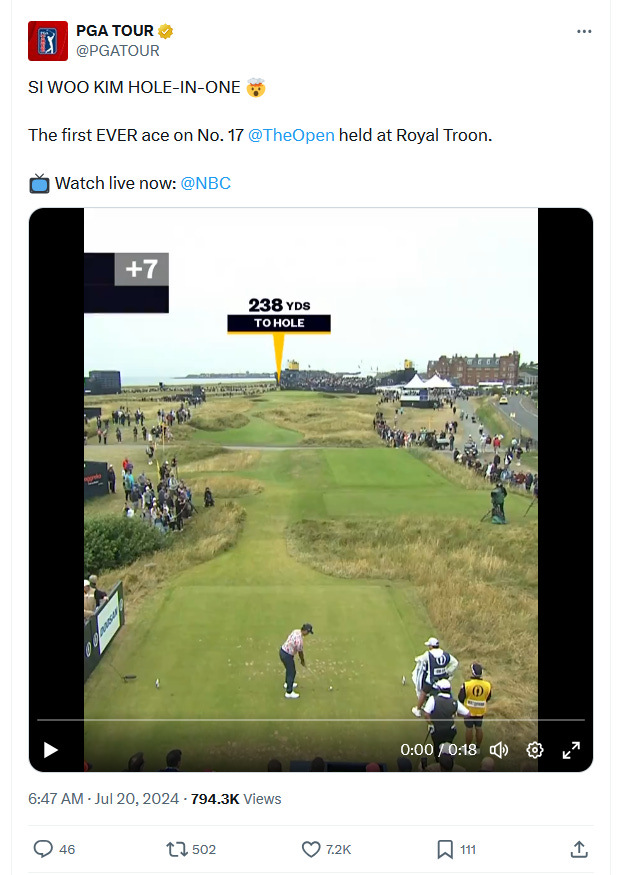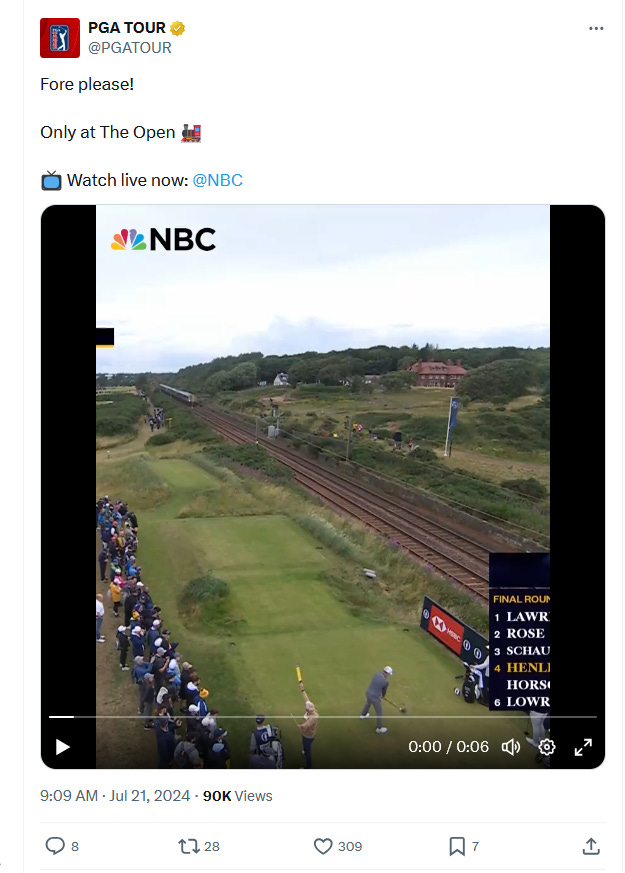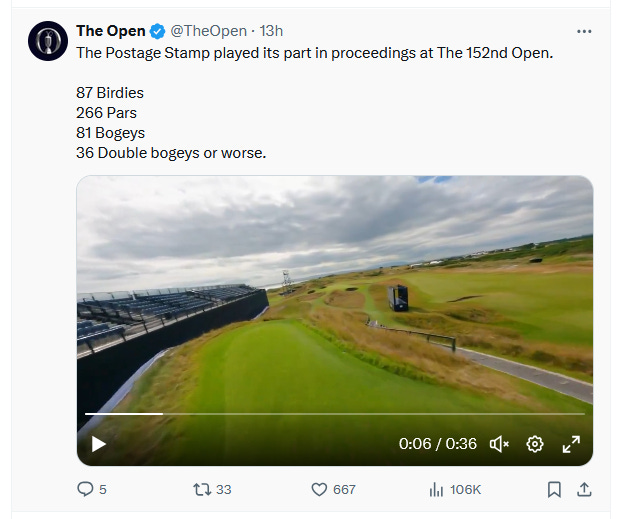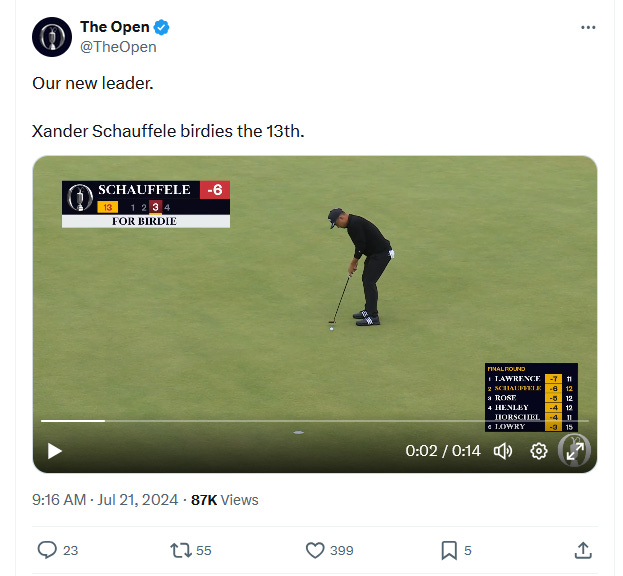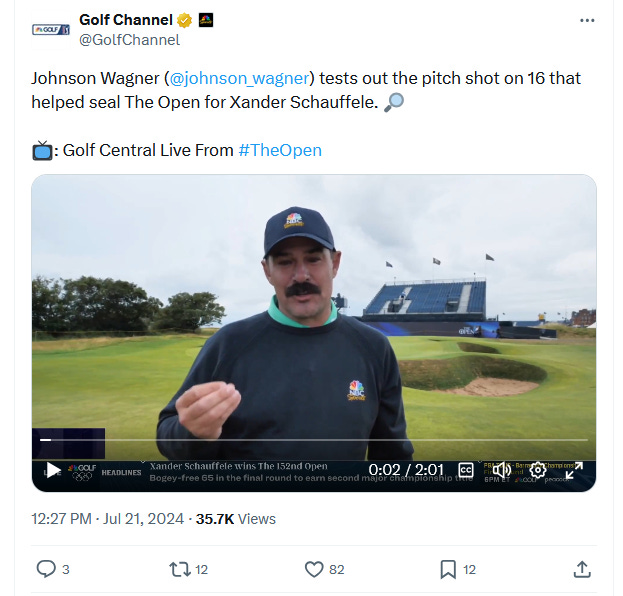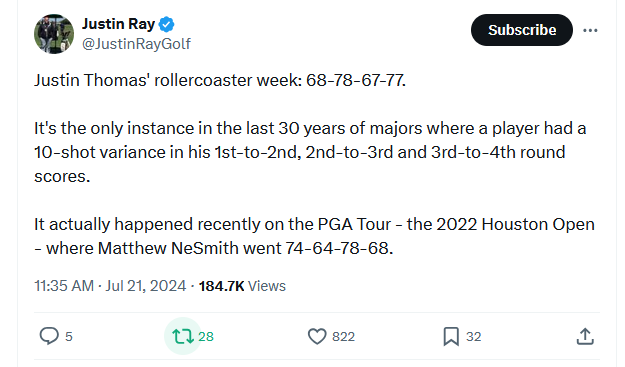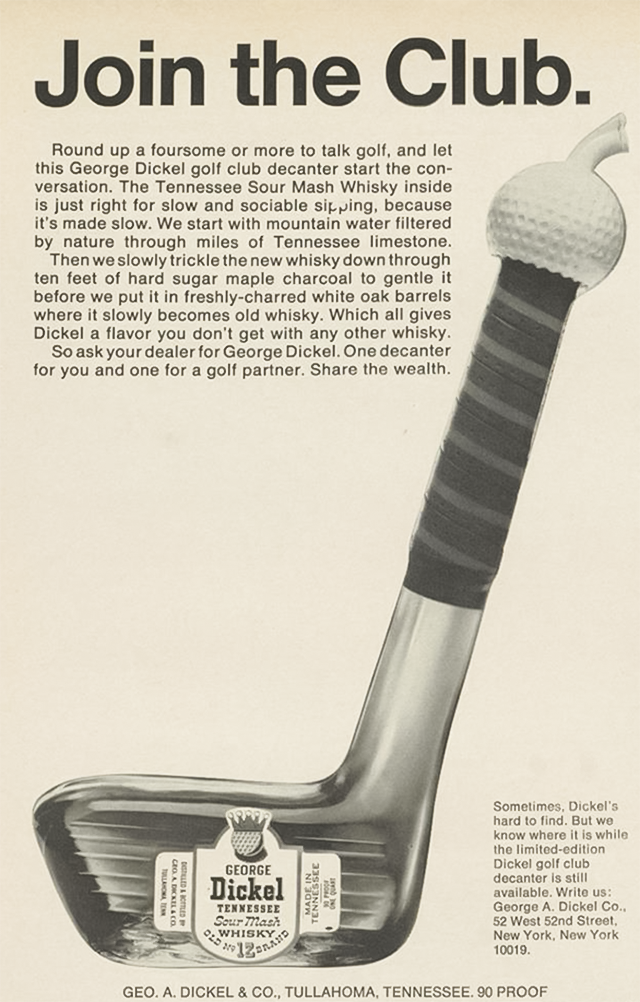Sikes Wins and Saves Tour
Dan Sikes wins the 1968 Minnesota Golf Classic amidst battle over the control the tour
All aboard for a journey through the past back to 1968 and the Minnesota Golf Classic. Dan Sikes came from way behind in the fourth round to capture the title. Scroll down to read how this tournament in St. Paul, once known as the St. Paul Open, struggled to attract big names and large crowds.
We’ve written about the 1964 St. Paul Open Championship won by Chuck Courtney HERE, and the 1963 event, won by Jack Rule, Jr, HERE, and you won’t believe the medical condition he had to overcome.
We lost a great one this week when Mark Carnavale passed away suddenly at the age of 64. Mark won the 1992 Chattanooga Classic and won Rookie of the Year the same year. In 2007 he transitioned to broadcasting and joined Sirius/XM for its coverage of PGA TOUR events. He also worked some tournaments for ESPN+.
His last event was covering the Scottish Open two weeks ago and he was scheduled to cover the 3M Open this week.
RIP Mark Carnavale, thank you for bringing us inside the ropes with your coverage.
Read More from Golfweek by Todd Kelly HERE.
We have some exciting news about the progress being made on the documentary movie based on my book about Tony Lema. We’ll be updating the news in upcoming editions of Tour Backspin. We now have a website that features a trailer. Check it out by clicking on the clip below.
It is so much fun to wake up early and watch The Open Championship on television. It was quite the tournament—congratulations to Xander Schauffele on winning his second major of the year. Scroll down for the tournament wrap-up, a few thoughts from me, and the Clips You Might Have Missed.
It’s never too early to start the Player of the Year Award discussion so let us know who ya got in the Tour Backspin Poll, and this week’s Music Clip features Canned Heat performing “On The Road Again” live on the Playboy After Dark television show. Scroll down to listen. We dug deep and found a video of the swing of Tacoma’s Ken Still for this week’s Swing Like a Pro feature. You should be able to figure out the WHAT HOLE IS IT? Presented by Rota Golf this week and then you may just win a golf swag prize pack. Rota Golf has a cool way to map out your bucket list journey of playing the top 100 courses in the U.S. We’ve got some links for you in the Check it Out section and an ad with a product I MUST HAVE is featured in this week’s Vintage Ad. Scroll down to view.
The latest episode of The Tour Backspin Show has dropped on YouTube for all subscribers. Our annual paid subscribers have had access to this podcast that features Lee Trevino receiving the Legacy Award from the Robert Trent Jones Society, and discussing his illustrious career. Early access to The Tour Backspin Show is one of the benefits of being a paid subscriber to Tour Backspin. Feel free to share this with your golf buddies.
Tour Backspin is a reader-supported publication. To receive new posts and support my work, consider becoming a free or paid subscriber.
We understand if a premium subscription isn’t in the budget, and we’re happy to have you here however you’ve arrived. You can sign up for a free subscription so you’ll never miss the newsletter. It will arrive in your inbox every Thursday. Paid subscribers help fund the work we do here at Tour Backspin.
We had a perfect split in last week’s Tour Backspin Poll where we asked if you had the over or the under score of 274 at The Open Championship. Both sides of the score received 50% of the vote. Xander Schauffele shot a nine-under 275, so the 50% of you who went with the over can go to the pay window.
This week we’ll wade into the Player of the Year Award. Who ya got?
Tour Backspin Poll
Do you know what happened today in golf history? Or which famous golfer has a birthday today? Me, neither. But I do know where to go to find out. Check out the Your Golfer’s Almanac podcast. Host Michael Duranko celebrates birthdays, milestones, and other accomplishments that occurred on this day in golf history. Listen HERE.
We’re playing St. Paul Open Trivia in this week’s Tour Backspin Quiz. Scroll down to play.
Did you miss a previous newsletter? You can view it HERE. Help us grow Tour Backspin! Please forward this email to a friend. Was this newsletter forwarded to you? You can sign up HERE.
Okay, we're on the tee, let's get going.
Enjoy!
Larry Baush
Dan Sikes Comes From Four Strokes Back To Win Minnesota Golf Classic
It is the third week of July in 1968 and Sam Gates, a lawyer who represented the players on the PGA Tour, and William Rogers, legal counsel for the PGA of America is attempting to amicably resolve the issue of who would control the tour. While the discussions were amicable, the issue had yet to be resolved and a player revolt seemed inevitable.
“We phoned and met a great number of times,” Gates said. "There was never any acrimony between us.”
The unresolved issues hung over the playing of the PGA Championship at Pecan Valley in San Antonio, and the Minnesota Golf Classic played the next week, July 25th through July 28th. Tournament sponsors of tour events had formed their own association, the International Golf Sponsors Association (IGSA), and had its own agenda concerning the tour.
“We’ll need a strong daily ticket sale to finish in the black.”
The Minnesota Golf Classic highlighted several of the concerns of the sponsors as it was a tournament that did not attract a strong field and struggled to make money. On Wednesday, the day of the pre-tournament pro-am, Jim Adams of the local Jaycees, the sponsor of the tournament, addressed the press with his concerns about the tournament making a profit.
“Our advance sale is about where it was two years ago,” he said.
This was not optimistic news as the tournament went deeply into the red in 1966.
“We’ll need a strong daily ticket sale to finish in the black,” he concluded.
Part of the difficulty in turning a profit was the strength of the field. The Minnesota Golf Classic followed the PGA Championship that was played in the heat in San Antonio and many of the top players, including the winner, Julius Boros, were exhausted and several last-minute cancellations flooded the tournament headquarters on Tuesday. Lee Trevino, the U.S. Open Champion, and Tom Weiskopf, winner of two events so far in 1968, were the two top draws. There were only five winners of the 28 tournaments played so far for the year who would tee it up at Keller Golf Course, located northeast of St. Paul.
Trevino showed up because he believed he should play in every tournament on the tour at one point or another. Weiskopf admitted he was exhausted but explained that he came to St. Paul because it was his wife’s hometown.
“I need a rest badly,” Weiskopf said. “The only reason I’m here is because of my wife.”
“This is one of the oldest tournaments on the tour,” Trevino said after his pro-am round. “I feel I owe it to the sponsors to play.”
“Today I played for the members. Tomorrow, I play for old Lee’s family.”
Trevino thoroughly entertained spectators at the pro-am even using a Dr. Pepper bottle to hit a 100-yard approach shot on one hole. He had just signed a $200,000 endorsement with the soft drink company. He didn’t even keep score, his caddie did, and he estimated he shot a 76 or 77.
“Today I played for the members,” Trevino said. "Tomorrow, I play for old Lee’s family.”
Terry Dill posted the lowest round in the pro-am with a six-under-65 and won $500. He ran off six straight birdies on his second nine holes on the front nine at Keller (he started on the 10th hole). Keller, a par-71, 6,702-yard course, was known for surrendering very low scores to the touring pros. Tommy Aaron and Steve Oppermann shared second-place honors shooting 67 while Dan Sikes, Dick Crawford, Frank Boynton, and Gordon Jones were next with 68s. Sikes, a non-practicing attorney, was deeply involved with trying to find a resolution between the players and the PGA of America concerning the control of the tour.
While the pros usually took advantage of Keller Golf Course, Thursday’s first round saw a full-on assault on par. Five players scored 66, three recorded a 67, seven had 68s, 18 carded a 69, and 17 shot 70. That adds up to 50 players who broke par.
Leading the assault were Harry Toscano, J.C. Sneed, Pete Brown, Bob Stanton, and Jim Colbert who all had a 66. Tom Weiskopf was one of the players at 69, as was Lou Graham. Lee Trevino, playing with Pete Brown, one of the few Black players on the tour, joked and wisecracked his way to a 74. Ken Still was also at 74 while Dan Sikes was at 71.
“I just came up here to see all my friends,” Trevino quipped to reporters after his round. “I don’t need the money. I like this course, and I hit the ball well on it, but I just couldn't drop a putt. But I’d never fault this course. I had a hell of a good time today.”
The highlight of Brown’s round was an eagle on the par-5, 533-yard 3rd hole.
“I hit the driver real good, and I putted the best I have in a long time,” Brown said after his round.
Brown, the winner of only one tournament in his five years on tour, and Toscano, a second-year pro from New Castle, PA, continued their assault on par with both shooting a 67 in the second round. They were tied for the lead at 9-under-par 133, one stroke in front of Jim Colbert who had a second round 68. Tommy Aaron was one stroke back after a 66 while Weiskopf was another stroke back at 136 after a 69. Still was tied with Weiskopf after shooting a 67, and Sikes was at 137 after a second round 66. Lee Trevino missed the cut after shooting a second round 72, three stroke above the cut line.
Reporters were interested in the players’ views on the difference between Hazeltine National Golf Club, host of the 1967 Minnesota Golf Classic, and Keller Golf Course.
“You can’t compare the two,” Brown answered. “That Hazeltine is 8,000-yards long. I think it’s the toughest course in the country, it and Firestone.”
“I think your average golf fan would rather see a tournament on a course like Keller where the pros can get to the greens easily and get those putts rolling. Fans like to see birdies.”
After glancing at the scoreboard, Toscano said, “That tells the difference. It took 143 to make the cut here. What was it at Hazeltine?”
The answer was 151.
“I think your average golf fan would rather see a tournament on a course like Keller where the pros can get to the greens easily and get those putts rolling,” Toscano went on. “Fans like to see birdies.”
One flaw in that argument was that the total attendance at Kellar for the first two days was 6,266 compared with the two-day total of 15,120 at Hazeltine the year before when the field attracted more of the big-name players. In 1968, season tickets went for $15 while daily tickets went for $5.
Just about everybody on the grounds at Keller was surprised to see Lee Trevino on Saturday as he had missed the cut. But there he was on the practice tee and the putting green cracking jokes to the spectators and press.
“I really felt badly about missing the cut,” Trevino explained. “Especially after all they did for me in this tournament. So, I figured I’d stay around for a couple of days and work on my game. I haven’t had much of a chance to practice lately.”
Trevino, who was staying with friends, promised to return to Keller the next day before heading to Chicago for the Western Open.
A swirling wind provided the challenge that Keller needed in the third round, as did the pressure of playing on the weekend. Scores were higher and the results were anything but predictable.
At the end of the day, it was Brown and Lou Graham who sat atop the leaderboard with a score of 204. Brown fired a 71, including bogeys on the last two holes, while Graham matched the day’s lowest score, a 67. Graham bogeyed the final hole. At 205 sat Still who had a 69 with 16 pars and two birdies, Aaron, who had a 70, Terry Dill who moved up after a 68, and Jim Colbert who added a third round 71 that included bogeys on 16 and 18.
The fatigued Weiskopf hit his second shot on the 12th hole out of bounds and came in with a 74 putting him at 210, six shots off the leaders.
“You think the collar won’t be getting tight tomorrow?”
The pressure would be even more prevalent in the final round as seven of the top nine scorers had never won a PGA sanctioned event. Brown had won the Waco Turner in 1964 while Graham was the defending champion at the Minnesota Golf Classic.
“You think the collar won’t be getting tight tomorrow?” Jim Colbert asked with a chuckle.
Dan Sikes ran into Bob Gorham, the field secretary for the PGA, on Sunday before his round and the two stopped to chat.
“If I can birdie three of the first five holes, they’ll have to catch me,” Sikes told Gorham.
“On eight, I did the impossible. I blasted out of a bunker, and it rolled in from about 30 feet.”
He backed it up, too. After cutting the dogleg with his drive to just in front of the green, he birdied the 1st hole, added another at the 3rd after a bogey at the 2nd, but came back with another birdie at the 5th. He then birdied the next four holes to make the turn in 30 needing only 10 putts. Sikes birdied the 7th with an 18-foot putt and received a minor miracle on the 8th hole.
“On eight, I did the impossible,” he related to reporters. “I blasted out of a bunker, and it rolled in from about 30 feet. From then on, I knew somebody was helping me. It was one of those rounds that makes you feel somebody up there is with you.”
He took those optimistic heavenly intervention feelings into the back nine. He added a birdie at the 14th hole, sinking a 10-foot putt, and then made another 10-footer for birdie at the 16th hole. Sandwiched between those birdies was a three-putt bogey on the 220-yard, par-3 15th hole. His birdie on the 16th hole gave him the lead for the first time in the tournament.
Graham and Brown ran into problems on the back nine and the only player with a chance to catch Sikes was Ken Still. He led Sikes until he also ran into trouble on the 15th hole with a bogey after his 1-iron tee shot was wild. Sikes tapped in an 18-inch putt, after a great chip, at the last hole to shoot a 30-34—64 for a total of 272.
“That will pay the bills. Actually, I’m not too upset. In a tournament this close, it was bound to be decided by one stroke.”
At the last hole, Still needed to make a tricky 15-foot putt to finish in solo second edging out Tom Weiskopf who finished with a 64 to finish at 274.
Sikes won $20,000 which put him at $76,046 for the year, lifting him from 17th place on the money list to seventh place ahead of Jack Nicklaus, Arnold Palmer, and Frank Beard. Still won $12,000 for finishing second, the fifth tournament that Still had been runner-up. Weiskopf’s hot final round earned him a check for $7,500 that lifted him past Billy Casper into the leading money winner position.
“That will pay the bills,” Still quipped after the round. “Actually, I’m not too upset. In a tournament this close, it was bound to be decided by one stroke.”
Sikes spoke with Jack Goodwin of The Minnesota Star and said that he preferred to come from behind in the final round rather than going wire-to-wire.
“I’ve won tournaments both ways,” he said. “This way is easier. The pressure’s off in that kind of situation. If you shoot a 72 or a 73, nobody’s going to notice—not like they will if you’re one of the leaders. It puts you in a different frame of mind. You know you can throw caution to the wind and attack the course.”
After the victory in St. Paul, it was back to the meeting rooms, discussions about strategy, and other organizational duties related to the player’s desire to control the tour. On August 13th, the tour players voted to break away from the PGA of America, and on August 19th, Sam Gates announced the formation of the APG—American Professional Golfers, Inc. An advisory committee of 13 players had been created and included Dan Sikes. Other members of the advisory committee included Gardner Dickinson, Jack Nicklaus, Frank Beard, Doug Ford, Billy Casper, Kermit Zarley, Jerry Barber, Lionel Herbert, Dave Eichelberger, Dave Marr, and Bob Rosburg.
The APG lined up sponsors and created a schedule of 20 events for the 1969 season. ABC was threatening to pull out of their television deal with the PGA. The term of Max Elbin as the president of the PGA of America came to an end at the conclusion of 1969 and Leo Frasier replaced him. Frasier was much more open about reconciliation with the players than Elbin was and eventually, a deal was negotiated that resulted in the creation of the Tournament Players Division and the modern PGA TOUR. And Dan Sikes was a major player in that transition.
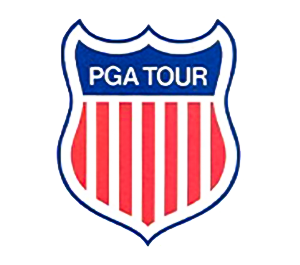
BONUS STORY
The 1968 Minnesota Golf Classic used a technology innovation to help fans on the grounds to follow the action in the tournament. IBM introduced a computer-driven sports messaging information service that was housed in a 40-foot-long mobile van at the 1967 Greater Dallas Open, and it was on the grounds at Keller Golf Course for the 1968 Minnesota Golf Classic.
The message board kept spectators up to the minute on developments on the course showing where players stood in relation to par. Before this innovation, fans could only keep up with the action by using transmitters to listen to a closed circuit radio broadcast—if available. Otherwise, fans relied on information, often incorrect, from other fans.
The messaging board, what we now call leaderboards, were positioned so that fans at the 9th or 18th green could easily see where the leaders were on the course and in relation to each other.
What Hole is It? powered by Rota Golf. Doesn’t your bucket list journey deserve one of these?
WHAT HOLE IS IT?
Are you on the leader board?
Congratulations to James Deaton, who correctly identified #11, the “Railway” at Royal Troon in Troon, Scotland, in last week’s WHAT HOLE IS IT? contest. James beat out eight other correct answers in the random drawing. We’re sending a prize pack of golf swag, including new stickers, to James. Submit your answer for this week and get yourself into the race for the Herbert C. Leeds Trophy, our new perpetual trophy for the annual winner.
PGA TOUR Wrap-Up | The Open Championship
The 152nd Open Championship saw a bit of everything. There was wind, rain, and the magic of links golf. Xander Schauffele outlasted Justin Rose and Billy Horschel to capture the Claret Jug after a flawless Sunday round on the difficult Royal Troon Golf Club.
After Schauffele made the turn in 34, he put on a burst of golf that proved decisive. He had a tap-in birdie at the very difficult 11th hole, known as “Railway.” It was a hole where many a player saw his hopes dashed with gorse and out of bounds on the right and gorse on the left. Schauffele’s birdie was the only one in the final round.
He then birdied the 14th and 16th holes which gave him a three-shot lead, and after a par on the 17th hole, he had the luxury of walking up the final hole with the title firmly in hand.
Justin Rose birdied the last hole to record a 67 and shared second-place with Billy Horschel who birdied the 16th, 17th, and 18th holes for a 68. They finished two shots behind Schauffele. Thristen Lawrence finished in fourth place at -6 after holding the lead at one point on Sunday.
“Oh man... it’s been quite a journey,” Schauffele said after being handed the Claret Jug. “I feel very honored hearing my name called with ‘Open Champion’ right after it. It’s something I have dreamed of for a very long time.”
See Sunday’s best pictures HERE.
The PGA Tour held a modified Stableford event, the Barracuda Championship, at the Tahoe Mountain Club (Old Greenwood), and it was won by Nick Dunlap for his first PGA TOUR victory as a pro. Watch the top ten shots HERE.
Clips You Might Have Missed
Always nice to have the first EVER.
Love “Railway.”
How fun is the “Postage Stamp?”
Schauffele for the lead.
This person had the best major season, without winning one, this year.
Rollercoaster!
Tour Backspin Quiz | St. Paul Open Trivia
Who won the most St. Paul Opens? What years did he do it?
Scroll down for answer
Swing Like a Pro
Rare footage of Ken Still’s golf swing.
Blind Shot
Click for something fun. 👀
Kyle Porter’s Open Championship takeaways at CBS Sports.
Jack Hirsh of Golf.com writes about the tight Player of the Year race.
Tour Backspin Music Clip
Canned Heat performs “On The Road Again” on the “Playboy After Dark” television show in January of 1970. The song was first recorded in 1968
This biography of Tony Lema is one of the best golf books out there. Great research and writing. Highly recommended!
Bill via Instagram
Uncorked, The Life and Times of Champagne Tony Lema tells the story of one of the tour’s biggest stars in the mid-1960s. A fascinating glimpse into the traveling caravan that was the PGA TOUR during an era where the fields were full of “Mad Men” era personalities. From a hardscrabble youth spent on the “wrong side of the tracks” in the Oakland suburb of San Leandro, to the temptations of Elko, Nevada, to the bright lights of the PGA TOUR, Uncorked tells a story of determination, redemption and, above all else, a love story that documents how Betty, Tony’s new wife, provided the direction and motivation for him to become a top star. Order on Amazon.
Tour Backspin Quiz Answer:
“Lighthorse” Harry Cooper won the St. Paul Open in 1930, 1935, and 1936. He was given the nickname “Lighthorse” for his speed of play.
Thank you for reading this far, I know your time is valuable and choosing to spend some of it on what I’ve created is gratifying. If you want to help support the work we’re doing, please consider upgrading. It’s just $36 a year and you’ll be helping to tell the stories from one of golf’s golden ages.
Vintage Ad
Final Thoughts
I must play the “Postage Stamp.”
With Schauffele winning the Open Championship, all four majors were won by Americans this year. That hasn’t happend since 1982 when Craig Stadler (Masters), Tom Watson (US Open and The Open), and Raymond Floyd (PGA Championship) did it. (h/t Bill Fields, The Albatross on Substack)
I still can’t get over that picture of Tiger’s leg.
Went on my annual golf buddies trip, and this year we went to Gearhart Golf Links and it was so much fun. I will be writing a course review for paid subscribers of Tour Backspin in the next week. Upgrade for special articles, videos, movie updates, and other fun stuff.





